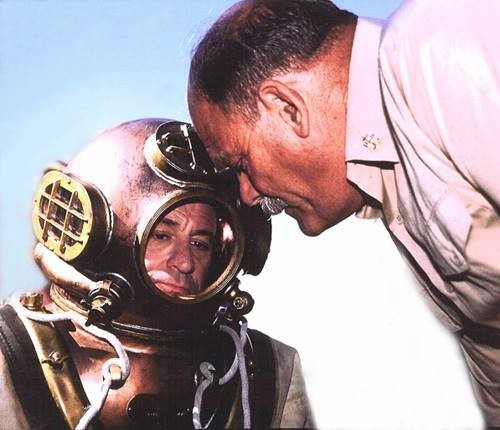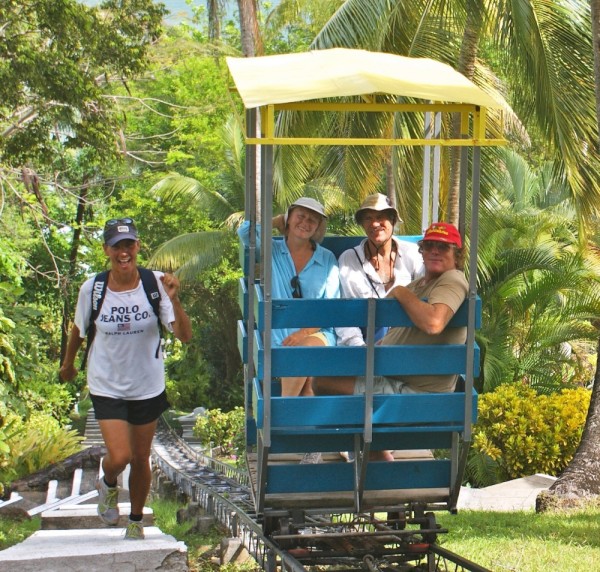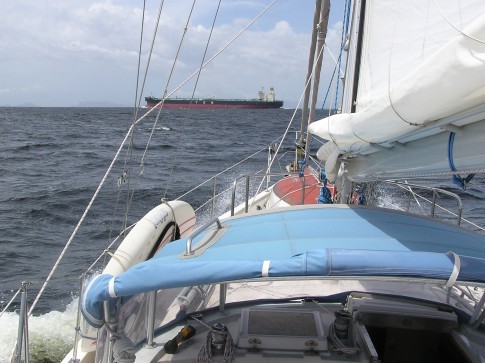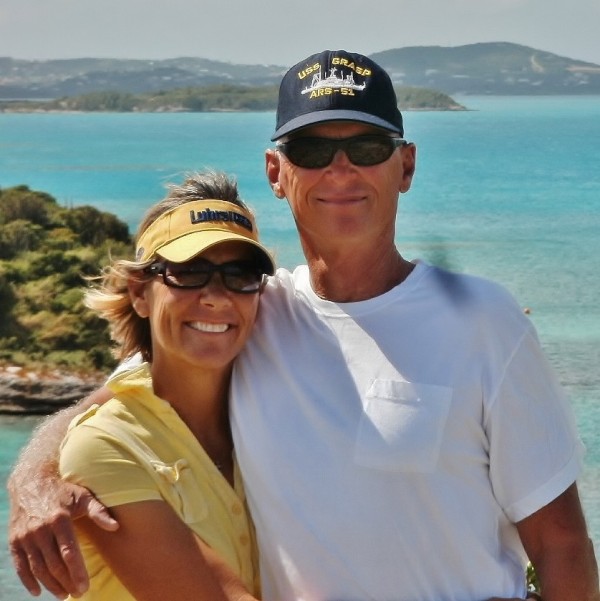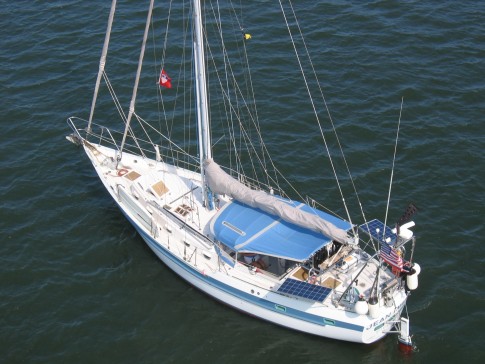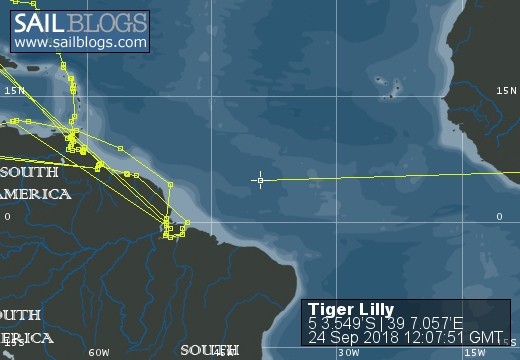
S/V Tiger Lilly
Rig heavy, reef early, and pray often; for God does not assure us an easy passage, but He does promise a safe anchorage...
25 May 2018 | TRINCOMALEE, SRI LANKA
02 January 2018 | Clan Jeti Anchorage, Georgetown, Penang Island, Malaysia
03 November 2016 | Singapore, Southeast Asia
02 October 2016 | Kumai River, Borneo
24 August 2016 | Rindja Island, Indonesia
22 July 2016 | Fannie Bay, Darwin, Northern Territory, Australia
14 June 2016 | Pancake Creek, Queensland, Australia
13 June 2016 | Pancake Creek, Queensland, Australia
11 June 2016 | Burnette Heads, Queensland, Australia
07 June 2016 | Mooloolaba, Queensland, Australia
11 May 2016 | Colmsie, Brisbane River, Queensland, Australia
23 December 2015 | Brisbane, Australia
13 August 2015 | Whangarei, New Zealand
07 August 2015 | Whangarei, New Zealand
23 July 2015 | Whangarei, New Zealand
12 April 2015 | Whangarei, New Zealand
11 February 2015 | Whangarei, New Zealand
25 January 2015 | Whangarei, New Zealand
24 September 2014 | BORA BORA, French Polynesia
23 September 2014 | Bora Bora
TIGER LILLY - GIRL OVERBOARD!!!
06 October 2011 | St. Augustine Marine Center
Capt. Tom Service

Tom wrote this article several years ago for the CSY sailboat discussion list. We hope that it will help when you think about offshore safety, and plan out your strategies for keeping your crew aboard and safe.
GIRL OVERBOARD
Perhaps the greatest fear that any offshore skipper has is losing a crewmember overboard while on passage. The main objective of any ocean voyage is to depart and arrive with the same souls-on-board. Souls-on-board is in-fact the official term used to describe a vessel's crew, and the very name depicts the depth of responsibility for which a captain has for his crew. Even if the vicissitudes of the sea come to bear and the vessel herself is lost, that is not the worst that can happen: if we all make it into the liferaft, it is only a boat and boats are replaceable - but not so with a human life. In the case of a sinking, the very effective international SARSAT System has proven itself many times over; the EPIRB will quickly pinpoint a liferaft anywhere in the world, call the cavalry, and all will be well. But time and again human response has fallen short once the Great Ocean swallows a person; the terror and helplessness felt by those left onboard would be overwhelming - and especially so if it is your precious daughter who is lost. In 1991 while on passage in the South Atlantic my daughter Dawn went overboard, and we had mere minutes to avoid such a heart wrenching loss...
We were in the final year of a 4 year circumnavigation, and there were four people aboard my CSY44 walkover sailboat; Dawn (age 16) Jennifer (age 14), my daughter's mother, and myself. We were sailing from Cape Town to Saint Helena, and were just coming off a period of sloppy weather associated with a front coming up out of the Southern Ocean. The wind was down to less than 10 knots, but the sea was still lumpy and confused, the wind-vane self-steering gear was struggling to keep the course, the sails were barely drawing and were annoyingly slatting back and forth as we rolled - very frustrating conditions indeed. Throughout the previous evening, we had been making good speed broad reaching wing-on-wing on the port tack under single reefed main, stays'l, and genoa. By mid-morning the wind was down and the genoa, which was still poled-out to windward, was not doing much. As the boat rolled the sail tried to slat itself to death. I decided to furl the genoa and stow the whisker pole to reduce the outboard weight and reduce the rolling.
Our standard down-wind rig consists of the mainsail vanged, guyed, and sheeted to leeward; staysail double-sheeted flat & hard centerline (reduces the roll, and it helps the wind-vane self-steering gear keep a course downwind as it prevents the head from climbing up on the wind in a puffer); and the genoa poled-out to windward on a whisker pole. The whisker pole is on a track on the forward side of the mast, and it is set independent of the headsail with a topping lift to the mast just below the inner forestay, fore-guy to a forward mooring cleat, and the aft-guy made fast to the midships mooring cleat; this enables the sail to be furled or reefed without having to work the pole. When the mainsail's vang is set up the boarding gate lifeline is open; the vang is attached to the bulwark cap rail at the boarding gate, and the gate fouls the almost vertical vang purchase.
On this particular morning, my daughter Jennifer and her mother were below in the main cabin doing schoolwork. Tom and Dawn were on deck getting ready to furl the genoa and stow the whisker pole. Tom was on the foredeck and Dawn was on the starboard side deck at the boarding gate. We were each wearing work type flotation vests, but neither of us had a life-harness on as it was during daylight conditions and the wind was down. Dawn verbalized my worst nightmare in a single sharp, "eek!" when the boat took a wicked snap roll and then I heard a splash as she went ass over teacup through the open starboard boarding-gate and into the sea. I hollered, "MAN OVERBOARD, STARBOARD SIDE" immediately pointed at her, and moved aft down the deck to the starboard shrouds to hang on - NEVER TAKING MY EYES OFF HER...
As a retired Naval Officer I was familiar with man-overboard procedures, and had conducted hundreds of man overboard drills. The main thing that my experience taught me is the certain knowledge that I could not take my eyes off Dawn for even a second; if I lost visual contact, we would likely never see her again. My first instinct was to determine if she was able to keep herself afloat and upright with her face out of the water; if she had suffered trauma as she went over the side, she may have needed my immediate assistance to survive. Dawn was a savvy boat kid, and as soon as she hit the water she had the presence of mind to hold her arm up with her thumb and pointer finger in the okay sign - so I knew she could take care of herself until we could turn around and pick her up. Of course, my next thought was wondering if Jaws was following in our wake, as he often does on passage; but then I could not do anything about that...
Within a second of my shout, Jennifer and her mom were in the cockpit ready to respond. My orders were 1) deploy the red cockpit throw cushions 2) right full rudder - we turned the boat towards the person in the water so that I did not lose visual contact 3) Start the engine - ahead full. The wind was nearly slack so we just ignored the sails and used the engine to power the boat around. I hung on to the shrouds with one hand and pointed at Dawn with the other as we turned; first beam-on to the sea (rolling deeply) and then up into the eye of the wind. I never took my eyes off Dawn and I never stopped pointing at her. This helped to inform and reassure her mother at the wheel - there was complete silence about the deck with the exception of my conning orders. I directed the movements of the vessel from the starboard-side boarding gate, giving my ex-wife engine and rudder orders. I had Jennifer roller-furl the genoa as we came around, and then had her stand by with the boat hook (which it turned out we did not need). We did a single tight turn, backed-down and brought the boat dead in the water with Dawn at the starboard boarding gate. As the boat rolled towards her I reached over the side and grabbed her by the collar loop on her life jacket, and snatched her to the cap rail in a single movement. Our family / crew had functioned effectively under very stressful circumstances; and Dawn was not in the water for more than five minutes - it all happened so fast. Once we had this soaking wet skinny teenager back in the cockpit safe and secure, the family gathered around her. As the realization of what could have happened set in, we all began to tremble.
When I was the skipper of a Navy salvage and rescue ship, I used to tell the crew that if anyone fell over the side at sea, once they surfaced and read the name Grasp on the stern of the ship, that the best thing they could do was to make peace with their Maker. I regularly reminded them that if they went over the side it was very unlikely that we would ever be able to find and recover them - particularly if we were towing. I taught my family the same thing on our sailboat.
Dawn reported the incident from her perspective thusly: She bent down to pick up a line on deck just as the boat took a wicked snap roll, and she was pitched right past the vang and through the open boarding gate. She said that once she hit the water she saw me looking down at her, and gave me the okay sign, and then the boat was gone. She read the boat's name and hailing port on the stern and said to herself - that is just what Dad said would happen. But just then a wonderful thing occurred - a warm and comforting feeling came over her, and she said that she felt the very presence of God come over her. She said that she knew in her heart that she was okay. Then she just laid back and watched us work the boat back to her.
Wow! The very presence of God is such a wonderful gift for a person to experience, and at such a young age.
WHAT WORKED:
Work vests - This incident occurred before SOS Suspenders were available. When at sea, during the hours of darkness we wore both a vest and a life harness when alone on watch or working on deck; and the rule for working on deck was that there had to be at least one other person awake to act as a safety observer. During the day, unless it was blowing a gale, we just wore a work vest on deck. Mobility on deck versus security is a trade-off that each boat / skipper / crew has to consider for themselves. A harness is very cumbersome to move around in, and more than once my harness has caused me problems on deck (even my retractable lanyard is a tripping hazard), but it certainly does keep one attached to the boat at all times.
Visual contact - Pointing at the person in the water and never losing sight of them is important; but of course that is not even an option if you are the only person left aboard the typical mom and pop cruising boat and have to work the vessel alone.
Operating procedures and training - The engine started easily, the crew kept their heads, and all of our equipment functioned correctly. If we had to go through all the complicated man overboard sailing procedures, our propensity for failure would have been greatly increased. Reaction time and simplicity are so very critical in this situation. We do have to be able to maneuver the boat under sail, but when it comes down to life and death - which is exactly what a man overboard is - I will use every asset at my command.
Standard engine and rudder orders - My daughter's mother never liked to drive the boat independently, and she never came out of the cockpit and on deck while underway, but she could understand and execute conning orders expertly. We often operated the boat in this manner as we left a dock, maneuvered through a crowded anchorage, or navigated in coral. This is an important team skill well worth knowing and practicing. It gets the captain off the wheel and in a position to see and do on deck. It never ceases to amuse me as I watch some big gorilla at the wheel of a power boat with a cigar in his mouth and his gut hanging over his belt shouting at Barbie on deck. She whines and cries and tries to use all of her 110 pounds of silicone and fluff to push the high-sided boat off the dock in an on-setting breeze. In the Ma & Pa Kettle cruising sailboat community, Pa is often way back in the cockpit barking orders at some sweet old gal on the foredeck. Ma would be more comfortable interpreting the mysteries of the Dewy Decimal System at the Monday morning Methodist Women's Book Club then trying to master the intricacies of a boat hook in one hand and a fender in the other. My advice is to get Mr. Tough Guy on deck directing the movements of the vessel with standard conning orders and doing the heavy lifting, with Ms. Sweetheart on the wheel executing those orders - and using her good judgment and observation skills to making sure that Mr. Tough Guy does not step on his pea coat sleeve.
Crew cross training - We operated the boat short-handed during our man overboard situation - the Captain could not participate in working the boat other than conning, and our best deck hand was in the water. A typical Mom & Pop cruising boat crew would be very limited with half the crew in the water.
Brightly colored throw cushions - Although we had a horse-collar float with a Dan-buoy attached, we were able to deploy the square red cockpit throw cushions very quickly. This does three things; the cushions mark a datum where the recovery started - and hopefully not too time-late, it provides a common visual point for the swimmer and the boat to rendezvous, and they provide positive flotation for a tired or injured swimmer. If visual contact is lost, these cushions establish a datum to deploy a more permanent marker and start an expanding search pattern. I would have immediately deployed the horse collar and Dan buoy if I lost sight of Dawn, but as long as I could see her I kept all my attention focused on that little blond head in those big blue waves. I am a real believer in these inexpensive red throw cushions - we have four on board and keep at least two in the cockpit at all times. These cushions are a simple, low tech, inexpensive asset - and they have multiple other uses: dinghy cushions in port, kids love to play with them while they swim, and they can prop up the Captain's head while he reads a book or discusses the affairs of the world. We never again saw that cushion we threw at Dawn, but it certainly did its job.
LESSONS LEARNED:
GPS - This incident occurred during the days of SATNAV and before GPS was common on recreational vessels. Today, especially on a short-handed Mom & Pop boat, the GPS is the only practical way to keep track of the person in the water - assuming the MOB button gets pushed, the time-late distance isn't too great, and the person left back aboard knows how to use the GPS information to return to the MOB.
Autopilot remote control - If the person left aboard had an autopilot remote control, they could steer the boat from on deck with an electric autopilot - which most boats already have. Being on deck, they would have a better vantage point for locating, or keeping track, of the MOB.
Lifelines - I realize now that rather than have the mechanical advantage of a vertical mainsail vang, if I angle it outboard on the boom from the cap-rail a foot or so, the life line gate can stay closed while the vang is in use. In practice the vang comes right up the center of the gate and it seems like it would block an exit (at least for a person my size), but somehow Dawn went right through there and did not touch a thing.
SOS suspenders - Although they are hot, heavy, and cumbersome, I try to always wear mine. However, I do not always clip in - it is a matter of individual judgment and experience. When agility is particularly important (like when working with the whisker pole) I often stay free with my lanyard tucked up into my vest so that I don't trip on it. The theoretical answer is always to stay clipped in, but for me, that is not always the most practical way. I not only have to be on deck, I have to move and work on deck.
Time late - It seems to me that the biggest problem on a Mom & Pop boat is to know just when the person goes over. While we were in New Zealand I saw an electronic device aboard a cruising boat that was about the size of a pack of cigarettes which was worn on a watch-standers life vest. When the distance between the life jacket unit becomes more than the programmed amount (boat length) a loud alarm sounds back onboard the boat. The Raymarine LifeTag crew overboard monitoring system works very similar, and this equipment is on S/V Tiger Lilly's Wish List. There are plenty of personal GPS systems with hand-held VHF combos available, but what is needed to solve the Time Late problem is a fully automated system that notifies the off-watch immediately of the MOB situation, and requires no action on the part of a possibly injured or unconscious crew. Existing units that notify the SARSAT system of a MOB are principally useful for body recovery - MOB is a local time-critical problem.
Recovery - Dawn was a skinny teenager, and although my arm and shoulder were a bit sore from snatching her from the sea, she was light enough for me to yank her up unassisted. If it had been a two hundred pound man that had fallen in the water - that would have created a major problem, and getting him back aboard would require a lifting tackle such as our LIFESLING recovery gear.
Well, there you have my experience with MOB at sea. We had a relatively easy situation: warm water, plenty of crew aboard, we were an experienced crew, the person was seen going over the side, a light weight uninjured person was in the water, and the weather wasn't too bad - if any one of these factors had been different I could have lost my precious daughter. The answer to the MOB situation is obviously prevention - the deck is stacked against us regarding discovery and recovery. Think about it.
GIRL OVERBOARD
Perhaps the greatest fear that any offshore skipper has is losing a crewmember overboard while on passage. The main objective of any ocean voyage is to depart and arrive with the same souls-on-board. Souls-on-board is in-fact the official term used to describe a vessel's crew, and the very name depicts the depth of responsibility for which a captain has for his crew. Even if the vicissitudes of the sea come to bear and the vessel herself is lost, that is not the worst that can happen: if we all make it into the liferaft, it is only a boat and boats are replaceable - but not so with a human life. In the case of a sinking, the very effective international SARSAT System has proven itself many times over; the EPIRB will quickly pinpoint a liferaft anywhere in the world, call the cavalry, and all will be well. But time and again human response has fallen short once the Great Ocean swallows a person; the terror and helplessness felt by those left onboard would be overwhelming - and especially so if it is your precious daughter who is lost. In 1991 while on passage in the South Atlantic my daughter Dawn went overboard, and we had mere minutes to avoid such a heart wrenching loss...
We were in the final year of a 4 year circumnavigation, and there were four people aboard my CSY44 walkover sailboat; Dawn (age 16) Jennifer (age 14), my daughter's mother, and myself. We were sailing from Cape Town to Saint Helena, and were just coming off a period of sloppy weather associated with a front coming up out of the Southern Ocean. The wind was down to less than 10 knots, but the sea was still lumpy and confused, the wind-vane self-steering gear was struggling to keep the course, the sails were barely drawing and were annoyingly slatting back and forth as we rolled - very frustrating conditions indeed. Throughout the previous evening, we had been making good speed broad reaching wing-on-wing on the port tack under single reefed main, stays'l, and genoa. By mid-morning the wind was down and the genoa, which was still poled-out to windward, was not doing much. As the boat rolled the sail tried to slat itself to death. I decided to furl the genoa and stow the whisker pole to reduce the outboard weight and reduce the rolling.
Our standard down-wind rig consists of the mainsail vanged, guyed, and sheeted to leeward; staysail double-sheeted flat & hard centerline (reduces the roll, and it helps the wind-vane self-steering gear keep a course downwind as it prevents the head from climbing up on the wind in a puffer); and the genoa poled-out to windward on a whisker pole. The whisker pole is on a track on the forward side of the mast, and it is set independent of the headsail with a topping lift to the mast just below the inner forestay, fore-guy to a forward mooring cleat, and the aft-guy made fast to the midships mooring cleat; this enables the sail to be furled or reefed without having to work the pole. When the mainsail's vang is set up the boarding gate lifeline is open; the vang is attached to the bulwark cap rail at the boarding gate, and the gate fouls the almost vertical vang purchase.
On this particular morning, my daughter Jennifer and her mother were below in the main cabin doing schoolwork. Tom and Dawn were on deck getting ready to furl the genoa and stow the whisker pole. Tom was on the foredeck and Dawn was on the starboard side deck at the boarding gate. We were each wearing work type flotation vests, but neither of us had a life-harness on as it was during daylight conditions and the wind was down. Dawn verbalized my worst nightmare in a single sharp, "eek!" when the boat took a wicked snap roll and then I heard a splash as she went ass over teacup through the open starboard boarding-gate and into the sea. I hollered, "MAN OVERBOARD, STARBOARD SIDE" immediately pointed at her, and moved aft down the deck to the starboard shrouds to hang on - NEVER TAKING MY EYES OFF HER...
As a retired Naval Officer I was familiar with man-overboard procedures, and had conducted hundreds of man overboard drills. The main thing that my experience taught me is the certain knowledge that I could not take my eyes off Dawn for even a second; if I lost visual contact, we would likely never see her again. My first instinct was to determine if she was able to keep herself afloat and upright with her face out of the water; if she had suffered trauma as she went over the side, she may have needed my immediate assistance to survive. Dawn was a savvy boat kid, and as soon as she hit the water she had the presence of mind to hold her arm up with her thumb and pointer finger in the okay sign - so I knew she could take care of herself until we could turn around and pick her up. Of course, my next thought was wondering if Jaws was following in our wake, as he often does on passage; but then I could not do anything about that...
Within a second of my shout, Jennifer and her mom were in the cockpit ready to respond. My orders were 1) deploy the red cockpit throw cushions 2) right full rudder - we turned the boat towards the person in the water so that I did not lose visual contact 3) Start the engine - ahead full. The wind was nearly slack so we just ignored the sails and used the engine to power the boat around. I hung on to the shrouds with one hand and pointed at Dawn with the other as we turned; first beam-on to the sea (rolling deeply) and then up into the eye of the wind. I never took my eyes off Dawn and I never stopped pointing at her. This helped to inform and reassure her mother at the wheel - there was complete silence about the deck with the exception of my conning orders. I directed the movements of the vessel from the starboard-side boarding gate, giving my ex-wife engine and rudder orders. I had Jennifer roller-furl the genoa as we came around, and then had her stand by with the boat hook (which it turned out we did not need). We did a single tight turn, backed-down and brought the boat dead in the water with Dawn at the starboard boarding gate. As the boat rolled towards her I reached over the side and grabbed her by the collar loop on her life jacket, and snatched her to the cap rail in a single movement. Our family / crew had functioned effectively under very stressful circumstances; and Dawn was not in the water for more than five minutes - it all happened so fast. Once we had this soaking wet skinny teenager back in the cockpit safe and secure, the family gathered around her. As the realization of what could have happened set in, we all began to tremble.
When I was the skipper of a Navy salvage and rescue ship, I used to tell the crew that if anyone fell over the side at sea, once they surfaced and read the name Grasp on the stern of the ship, that the best thing they could do was to make peace with their Maker. I regularly reminded them that if they went over the side it was very unlikely that we would ever be able to find and recover them - particularly if we were towing. I taught my family the same thing on our sailboat.
Dawn reported the incident from her perspective thusly: She bent down to pick up a line on deck just as the boat took a wicked snap roll, and she was pitched right past the vang and through the open boarding gate. She said that once she hit the water she saw me looking down at her, and gave me the okay sign, and then the boat was gone. She read the boat's name and hailing port on the stern and said to herself - that is just what Dad said would happen. But just then a wonderful thing occurred - a warm and comforting feeling came over her, and she said that she felt the very presence of God come over her. She said that she knew in her heart that she was okay. Then she just laid back and watched us work the boat back to her.
Wow! The very presence of God is such a wonderful gift for a person to experience, and at such a young age.
WHAT WORKED:
Work vests - This incident occurred before SOS Suspenders were available. When at sea, during the hours of darkness we wore both a vest and a life harness when alone on watch or working on deck; and the rule for working on deck was that there had to be at least one other person awake to act as a safety observer. During the day, unless it was blowing a gale, we just wore a work vest on deck. Mobility on deck versus security is a trade-off that each boat / skipper / crew has to consider for themselves. A harness is very cumbersome to move around in, and more than once my harness has caused me problems on deck (even my retractable lanyard is a tripping hazard), but it certainly does keep one attached to the boat at all times.
Visual contact - Pointing at the person in the water and never losing sight of them is important; but of course that is not even an option if you are the only person left aboard the typical mom and pop cruising boat and have to work the vessel alone.
Operating procedures and training - The engine started easily, the crew kept their heads, and all of our equipment functioned correctly. If we had to go through all the complicated man overboard sailing procedures, our propensity for failure would have been greatly increased. Reaction time and simplicity are so very critical in this situation. We do have to be able to maneuver the boat under sail, but when it comes down to life and death - which is exactly what a man overboard is - I will use every asset at my command.
Standard engine and rudder orders - My daughter's mother never liked to drive the boat independently, and she never came out of the cockpit and on deck while underway, but she could understand and execute conning orders expertly. We often operated the boat in this manner as we left a dock, maneuvered through a crowded anchorage, or navigated in coral. This is an important team skill well worth knowing and practicing. It gets the captain off the wheel and in a position to see and do on deck. It never ceases to amuse me as I watch some big gorilla at the wheel of a power boat with a cigar in his mouth and his gut hanging over his belt shouting at Barbie on deck. She whines and cries and tries to use all of her 110 pounds of silicone and fluff to push the high-sided boat off the dock in an on-setting breeze. In the Ma & Pa Kettle cruising sailboat community, Pa is often way back in the cockpit barking orders at some sweet old gal on the foredeck. Ma would be more comfortable interpreting the mysteries of the Dewy Decimal System at the Monday morning Methodist Women's Book Club then trying to master the intricacies of a boat hook in one hand and a fender in the other. My advice is to get Mr. Tough Guy on deck directing the movements of the vessel with standard conning orders and doing the heavy lifting, with Ms. Sweetheart on the wheel executing those orders - and using her good judgment and observation skills to making sure that Mr. Tough Guy does not step on his pea coat sleeve.
Crew cross training - We operated the boat short-handed during our man overboard situation - the Captain could not participate in working the boat other than conning, and our best deck hand was in the water. A typical Mom & Pop cruising boat crew would be very limited with half the crew in the water.
Brightly colored throw cushions - Although we had a horse-collar float with a Dan-buoy attached, we were able to deploy the square red cockpit throw cushions very quickly. This does three things; the cushions mark a datum where the recovery started - and hopefully not too time-late, it provides a common visual point for the swimmer and the boat to rendezvous, and they provide positive flotation for a tired or injured swimmer. If visual contact is lost, these cushions establish a datum to deploy a more permanent marker and start an expanding search pattern. I would have immediately deployed the horse collar and Dan buoy if I lost sight of Dawn, but as long as I could see her I kept all my attention focused on that little blond head in those big blue waves. I am a real believer in these inexpensive red throw cushions - we have four on board and keep at least two in the cockpit at all times. These cushions are a simple, low tech, inexpensive asset - and they have multiple other uses: dinghy cushions in port, kids love to play with them while they swim, and they can prop up the Captain's head while he reads a book or discusses the affairs of the world. We never again saw that cushion we threw at Dawn, but it certainly did its job.
LESSONS LEARNED:
GPS - This incident occurred during the days of SATNAV and before GPS was common on recreational vessels. Today, especially on a short-handed Mom & Pop boat, the GPS is the only practical way to keep track of the person in the water - assuming the MOB button gets pushed, the time-late distance isn't too great, and the person left back aboard knows how to use the GPS information to return to the MOB.
Autopilot remote control - If the person left aboard had an autopilot remote control, they could steer the boat from on deck with an electric autopilot - which most boats already have. Being on deck, they would have a better vantage point for locating, or keeping track, of the MOB.
Lifelines - I realize now that rather than have the mechanical advantage of a vertical mainsail vang, if I angle it outboard on the boom from the cap-rail a foot or so, the life line gate can stay closed while the vang is in use. In practice the vang comes right up the center of the gate and it seems like it would block an exit (at least for a person my size), but somehow Dawn went right through there and did not touch a thing.
SOS suspenders - Although they are hot, heavy, and cumbersome, I try to always wear mine. However, I do not always clip in - it is a matter of individual judgment and experience. When agility is particularly important (like when working with the whisker pole) I often stay free with my lanyard tucked up into my vest so that I don't trip on it. The theoretical answer is always to stay clipped in, but for me, that is not always the most practical way. I not only have to be on deck, I have to move and work on deck.
Time late - It seems to me that the biggest problem on a Mom & Pop boat is to know just when the person goes over. While we were in New Zealand I saw an electronic device aboard a cruising boat that was about the size of a pack of cigarettes which was worn on a watch-standers life vest. When the distance between the life jacket unit becomes more than the programmed amount (boat length) a loud alarm sounds back onboard the boat. The Raymarine LifeTag crew overboard monitoring system works very similar, and this equipment is on S/V Tiger Lilly's Wish List. There are plenty of personal GPS systems with hand-held VHF combos available, but what is needed to solve the Time Late problem is a fully automated system that notifies the off-watch immediately of the MOB situation, and requires no action on the part of a possibly injured or unconscious crew. Existing units that notify the SARSAT system of a MOB are principally useful for body recovery - MOB is a local time-critical problem.
Recovery - Dawn was a skinny teenager, and although my arm and shoulder were a bit sore from snatching her from the sea, she was light enough for me to yank her up unassisted. If it had been a two hundred pound man that had fallen in the water - that would have created a major problem, and getting him back aboard would require a lifting tackle such as our LIFESLING recovery gear.
Well, there you have my experience with MOB at sea. We had a relatively easy situation: warm water, plenty of crew aboard, we were an experienced crew, the person was seen going over the side, a light weight uninjured person was in the water, and the weather wasn't too bad - if any one of these factors had been different I could have lost my precious daughter. The answer to the MOB situation is obviously prevention - the deck is stacked against us regarding discovery and recovery. Think about it.
Comments
| Vessel Name: | Tiger Lilly |
| Vessel Make/Model: | 1977 CSY44 walkover hull #55 |
| Hailing Port: | Green Cove Springs |
| Crew: | Lilly and Tom Service |
| About: | |
| Extra: | |
| Social: |
Tiger Lilly's Photos - Main
S/V Tiger Lilly
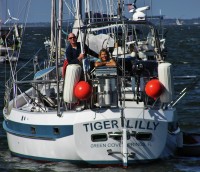
Who: Lilly and Tom Service
Port: Green Cove Springs



